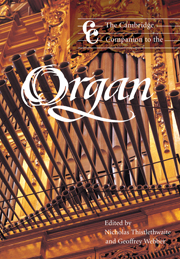Book contents
- Frontmatter
- Part I The instrument
- Part II The player
- Part III Selected repertoires
- 10 Italian organ music to Frescobaldi
- 11 Iberian organ music before 1700
- 12 The French classical organ school
- 13 English organ music to c1700
- 14 Catholic Germany and Austria 1648–c1800
- 15 The north German organ school
- 16 The organ music of J. S. Bach
- 17 German organ music after 1800
- 18 French and Belgian organ music after 1800
- 19 British organ music after 1800
- 20 North American organ music after 1800
- Appendix: The modes (toni) and their attributes according to Zarlino
- Notes
- Bibliography
- Index
10 - Italian organ music to Frescobaldi
from Part III - Selected repertoires
Published online by Cambridge University Press: 28 September 2011
- Frontmatter
- Part I The instrument
- Part II The player
- Part III Selected repertoires
- 10 Italian organ music to Frescobaldi
- 11 Iberian organ music before 1700
- 12 The French classical organ school
- 13 English organ music to c1700
- 14 Catholic Germany and Austria 1648–c1800
- 15 The north German organ school
- 16 The organ music of J. S. Bach
- 17 German organ music after 1800
- 18 French and Belgian organ music after 1800
- 19 British organ music after 1800
- 20 North American organ music after 1800
- Appendix: The modes (toni) and their attributes according to Zarlino
- Notes
- Bibliography
- Index
Summary
Introduction
Frescobaldi is obviously central to any discussion of Italian organ music. What is sometimes forgotten is that, like J. S. Bach, he comes at the end of a great tradition – at least as far as Italy is concerned. His most important pupil and follower was Froberger. Through him, and indirectly through others such as Kerll, Frescobaldi was to exercise considerable influence on German keyboard music, not least on Bach himself.
The great age of Italian organ building was already in decline when Frescobaldi was born in 1583. The last large instrument to be built was that by Luca Blasi for St John Lateran in Rome in 1598. The new enormous basilica of St Peter's where Frescobaldi was to serve most of his lifetime never had an organ commensurate with its size, its importance or the stature of its organist. Most seventeenth-century Italian organs do not extend below 8 C and have a range of four octaves (C/E–a2 or c3). Virtually all Frescobaldi's music can be played on such an instrument quite satisfactorily. This has given rise to the idea that the Italian organ was always a small instrument, especially since many such organs still exist and because the basic format remained unchanged for another two centuries. The bulk of this chapter will therefore attempt to explain the Italian scene up to Frescobaldi, relating its music not only to the large instruments that survive (e.g. San Petronio, Bologna, 1471; Arezzo Cathedral, 1534; San Giuseppe, Brescia, 1581; St John Lateran, Rome, 1598 – all of these based on 16′ or 24′ principali) but also smaller 6′ and 4′ organs.
- Type
- Chapter
- Information
- The Cambridge Companion to the Organ , pp. 148 - 163Publisher: Cambridge University PressPrint publication year: 1999



